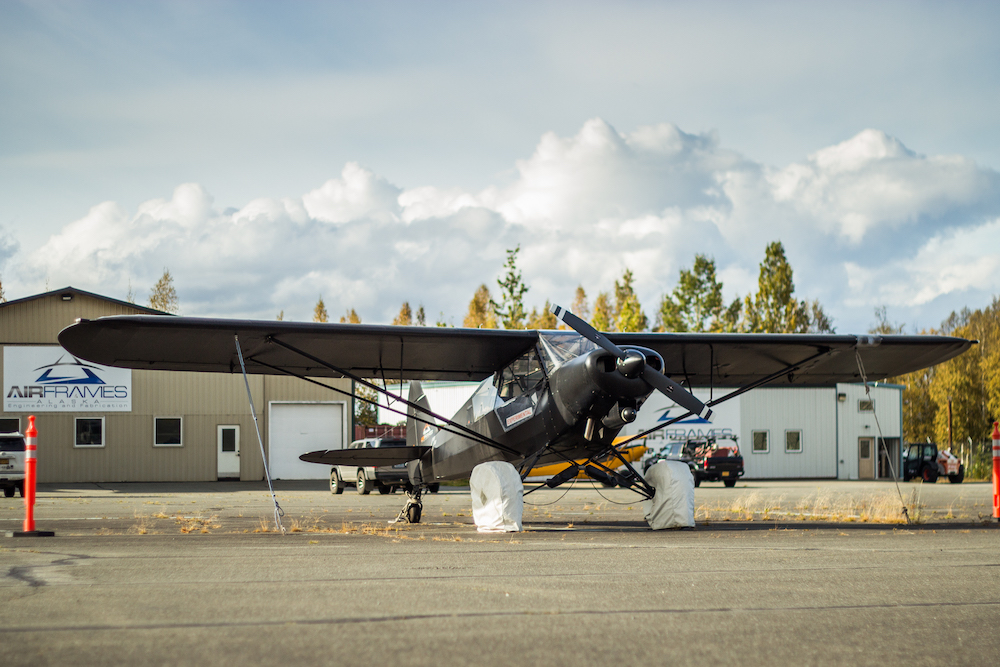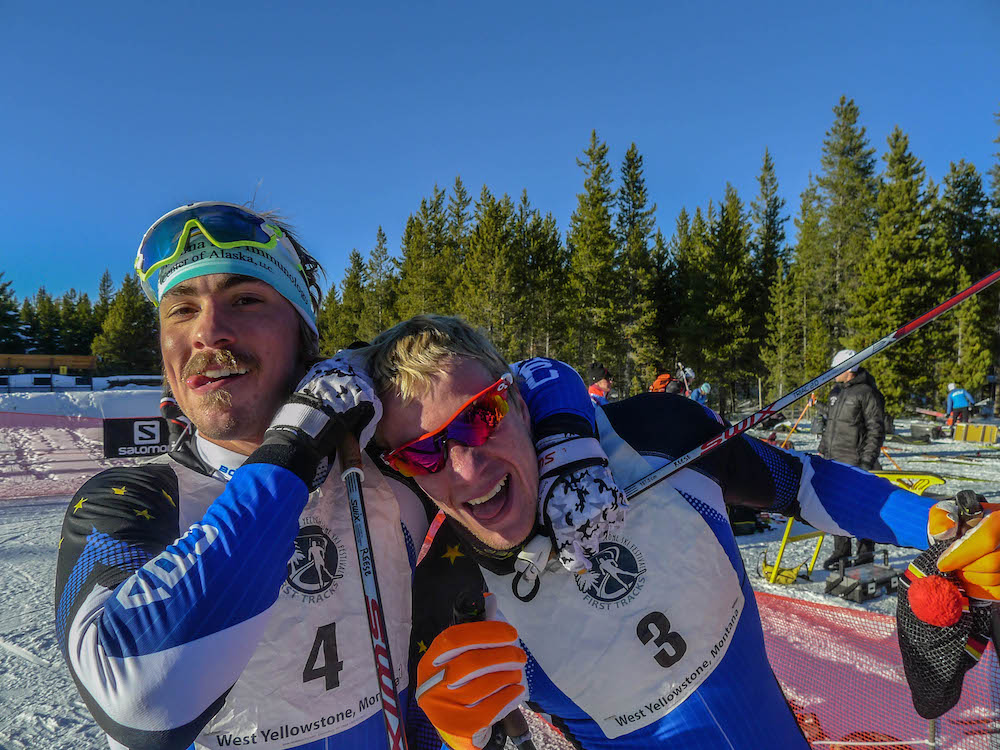
Earlier this season, Logan Hanneman talked with FasterSkier about his laser-like focus on the 2018 Winter Olympics, which start on Feb. 10 in PyeongChang, South Korea. The 24-year-old Fairbanks native, who now lives and trains 300 miles south in Anchorage with Alaska Pacific University (APU), was specifically eyeing the men’s individual classic sprint on Feb. 13. Although first he has to qualify to get there.
Entering this season, Hanneman was fresh off a freestyle-sprint title from 2017 SuperTour Finals at home in Fairbanks last March. It was his second SuperTour win after topping a skate sprint in West Yellowstone in November 2015.

“That race was the absolute highlight so far of my career,” Hanneman said of the SuperTour Finals win during a phone interview in September. “Not just because it was a national title but because it was in my home town. It was very special to be able to win that at home.”
He ended last season ranked sixth in the men’s SuperTour sprint rankings and 24th overall. So far this season, an Olympic season, Hanneman is seventh in the sprint standings and 11th overall for SuperTour points through two weekends of racing (see 2017-18 SuperTour Points link on right side of page).
Perhaps more notably, he’s placed second and third in two SuperTour sprint qualifiers: he was second in the skate-sprint qualifier Dec. 2 in West Yellowstone and third in the classic-sprint qualifier Dec. 9 at Sovereign Lake in British Columbia.
Hanneman went on to finish seventh in the West Yellowstone sprint and ninth overall in the B-final at Sovereign Lake.
What’s the significance of fast qualifiers? Everything, if you’re a sprinter trying to make the U.S. Olympic team.
According to the U.S. Ski & Snowboard athlete-selection procedures for the 2018 Winter Games, “Individual sprint events to be scored for the purpose of the [Olympic Winter Games] Selection List will only consider qualification-round finish placing.”
That means an athlete will be considered for the U.S. Olympic team based on Selection Criterion 3 (bottom of page 3 of this PDF document):
“Should there be any remaining positions after Selection Criteria 1 [World Cup results and standings] and 2 [discretion] have been applied, those positions may be filled by considering the athlete with the highest rank on the 2018 Olympic Winter Games Selection List,” the criteria states, “Which is an accumulation of SuperTour points scored during the selection period using the athlete’s best 2 finishes in a single discipline (sprint or distance) and using the OWG Selection List outlined in Attachment 1.”
“From a very literal view, I need to be one of the top (most likely The top), sprint qualifiers in the country after U.S. Nationals in January in order to make the 2018 Olympic Team,” Hanneman wrote in an email in September. “The qualification races are comprised of four sprints, where only the qualifier is scored for points towards the Olympic team (West Yellowstone SuperTour, Silver Star SuperTour, and U.S. Nationals (2 sprints)). On a more broadened view, I just need to improve my sprint qualification ability slightly. … I was close to qualifying for World Championships last year, which used the same qualification criteria. So that has been my focus this summer and will continue to be what I focus on in my training.”

Heading into U.S. Cross Country Championships, which begin Wednesday in Anchorage (the first sprint is the skate sprint on Friday), Hanneman has put himself in “podium” contention for a top qualifying result (although no actual podiums exist for those results at the SuperTour or U.S. nationals level this season — only the finalists get to stand on an actual podium).
He’s joined by top male SuperTour sprinters Nick Michaud of the Bridger Ski Foundation (who won the West Yellowstone skate-sprint qualifier as well as the final early last month, and qualified second in the Sovereign classic sprint before placing 12th overall), Cole Morgan of the Sun Valley Ski Education Foundation (who won the Sovereign qualifier and placed third in the final, and was fifth in the West Yellowstone qualifier and sixth in the final), and Ben Saxton of the Stratton Mountain School Elite Team (who was third in the West Yellowstone qualifier and fifth in the final, and eighth in the Sovereign qualifier and second in the final). And there are several others who are contenders for the upcoming nationals classic-sprint qualifier in Anchorage on Monday, Jan. 8.
Hanneman’s older brother, Reese, made it to the finals in both West Yellowstone and Sovereign, placing third in West’s skate sprint and fifth in the Sovereign classic sprint, after qualifying in seventh in West and fifth at Sovereign.
Reese, who turned 28 on Christmas, has two sprint national titles to his name (he won the 2016 skate sprint in Houghton, Michigan, and the 2014 classic sprint at Soldier Hollow in Midway, Utah.) In all, Reese has seven U.S. nationals podiums, according to the International Ski Federation (FIS) database.
Logan qualified second in the skate sprint at 2015 nationals in Houghton.
Last winter was Logan’s first season as a senior athlete. After missing out on qualifying for 2017 World Championships, he focused mostly on the domestic SuperTour circuit, but also ventured to Seefeld, Austria, for three days of Alpen Cup racing. There he finished 15th in the 3.3-kilometer freestyle prologue, 40th in the 15 k classic, and 37th in the 15 k freestyle pursuit.
“They were great races to do because they’re very stiff competition,” Logan reflected. “There’s a lot of Europeans there that are on and off the World Cup circuit.”
Two seasons ago, he competed at 2016 U23 World Championships in Rasnov, Romania, where he finished 15th in the skate sprint and 55th in the 15 k classic. He followed that trip with Alpen Cup races in Germany and Italy, and notably placed seventh in the 3.3 k freestyle prologue in Toblach, Italy.
After graduating from the University of Alaska Fairbanks in 2015, Logan has yet to race at the World Cup level. But after transitioning to life as a professional ski racer, who balances two training sessions a day with an engineering job, that remains one of his big goals. That and the Olympics.

“I do a lot of computer design work, and you get to watch what you design on the computer be made right downstairs in our machine shop,” he said of his part-time work with Airframes Alaska, a company that makes after-market upgrades for small aircraft, specializing in the Piper PA-18 Super Cub. “Working in the aircraft industry, there’s a lot of FAA compliance. I also help with facilities support projects. You never know what you’re going to be working on a week-to-week basis.
“They’ve been outrageously flexible with my skiing, which is unbelievably helpful for my first job as an engineer,” he continued. “I was able to set my work schedule around my training schedule. I train in the morning, drive out to work, then come home and do my second workout. When it comes into racing season, if I need to be gone, I’m able to leave for racing or training. It’s been a blessing. It’s awesome.”
Logan spoke with FasterSkier this fall as he was driving to work at an airstrip in Chugiak, about 20 miles northeast of Anchorage.
“I like being busy,” Logan said. “Work is not stressful at all because it’s outrageously fun. It’s what I really like doing. I never find myself too stressed with all this [work, training, life]. I think I’ve found a pretty good balance.”
Asked about what Logan brings to the APU program, Erik Flora, director of the APU Nordic Ski Center, wrote in an email: “We were excited to have Logan officially join our program [in 2015]. His skills and ability to move in a sprint make him one of the top developing sprinters in our country. He is extremely thoughtful about his training and his approach to skiing fast. He strengthens our team, both with results and as a strong teammate.
“His speed in the finish is one of the best I have ever seen,” Flora added.

Logan characterized himself as “one of a bunch of guys at APU that are pushing to try to make the 2018 Olympics this season. I tend to do better in sprints, so that’s going to be my primary focus.”
Late this summer, he experienced a back-pain flareup from an old injury. In 2013, Logan broke his back in a trampoline accident.
“I do a lot of core strength exercises to get stronger where I need it the most,” he explained. “For a few days I have to be really cautious until I get everything relaxed again.”
He added that swimming is a good alternative workout when his back bothers him. Other than the occasional back pain, he feels that he’s on track for this winter.
“My training’s been good. The group of guys here at APU are a pretty stellar training group,” he said. Logan is part of a training group of 14 men on the APU Elite Team, including U.S. Ski Team members Erik Bjornsen and Scott Patterson.
One of his teammates is his brother Reese.
“We’ve raced together for so many years, there’s not a whole lot of sibling rivalry,” Logan said of Reese. “In a race, he’s just another competitor. Sometimes it can be hard if things don’t go well for one of us. This year is gonna be tough because both of us are pushing for one of those sprint spots for the 2018 Olympics.”
“He’s really confident in his training plan, what it takes to do your best,” Reese said in a September interview. “It’s hard, there’s a lot of different ways to do it. Logan’s always very confident – he helps me in that way, too.
“He’s one of the best qualifiers,” Reese added.
— Alex Kochon contributed

Peter Minde
Peter Minde is a FasterSkier contributor and personal trainer specializing in functional strength and corrective exercise. Whether skiing, trail running, or cycling, he’s always looking to see what’s at the top of the next hill. From the wilds of north N.J., he skis for Peru Nordic. On Twitter @PeteMinde or at www.oxygenfedsport.com.



